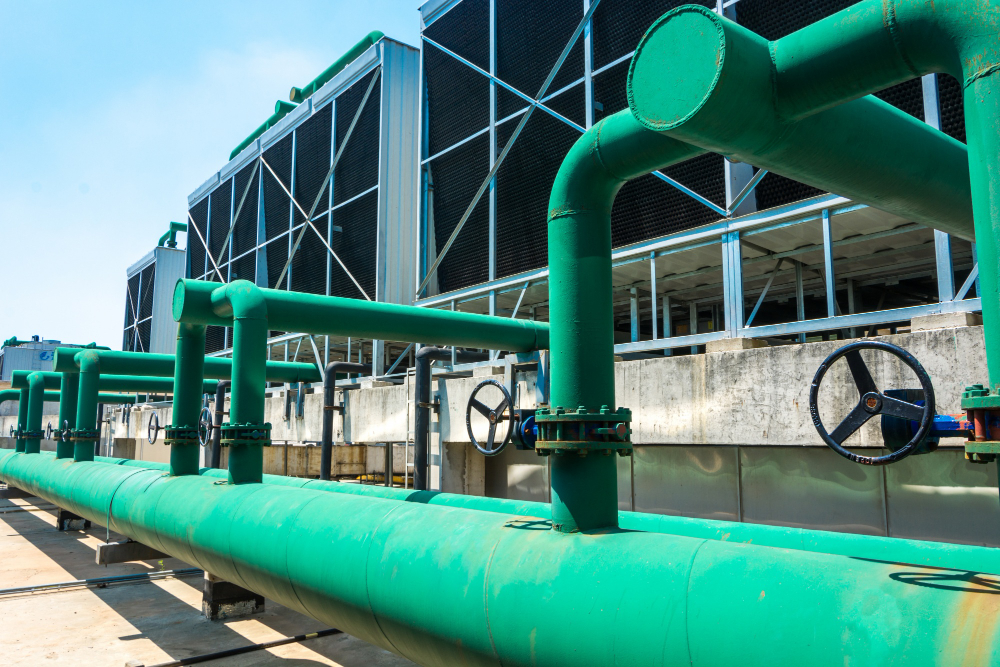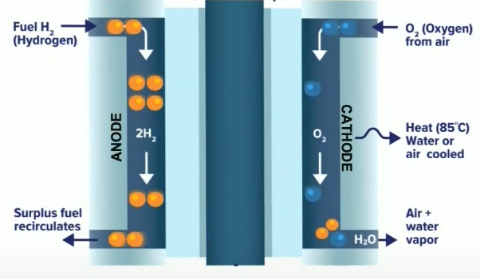5.2.2 Lecture Notes Energy Conversion Technologies
Course subject(s)
5. Multi-carrier Grid Integration

This image is from freepik.
This lecture will discuss different existing energy conversion technologies. The following techniques will be discussed:
- Power to gas
- Fuel cells
- Power to heat
- Combined heat and power
Power to gas
Power to gas (P2G) technology has recently become popular in the energy transition. An important characteristic of a technology is the Technological Readiness Level (TRL), which indicates how ready a technology is to be used. The basic principle of P2G is that electrical power is converted into gaseous fuels. The gasses that are being produced are hydrogen (when using electrolysis) or methane and syngas. There are three main types of electrolysis:
- Alkaline electrolysis, which has been around the longest. It has capacities in the order of 100 MW and its TRL is 9.
- Proton Exchange Membrane (PEM), which has recently gained much traction due to the high efficiency and stability. Its capacity is in the up to a few MW and the TRL of this technology is 9.
- Solid Oxide Cells (SOC), which is still a prototype. The capacity is a few KW, and it has a TRL of 5. However, the SOC has a better efficiency and power density compared to alkaline electrolysis or PEM.
Besides producing gaseous fuels, P2G also has advantages in an operational point of view. Because all the mentioned technologies have a fast response, it can help the power system with maintaining the power balance. This creates flexibility and stability.
Fuel cells
Fuel cells have the opposite working principle compared to power to gas, since they convert chemical energy into electrical energy. Fuell cells were developed in the 1830s but were used for the first time in the 1960s by the NASA for powering satellites. A fuel cell has an anode and a cathode, as shown in the figure below.

On the anode, hydrogen is oxidised, creating positively charged hydrogens ions and electrons. The hydrogen ions travel to the cathode, where water is formed from oxygen. At the same time, electrons move from the cathode to the anode in an external circuit, creating a direct current. For large fuel cells, the different cells are stacked, such that the produced power is significant. The largest fuel cell currently has a capacity of 59 MW.
Power to heat
Because half of the global energy consumption is heat, it is also essential to generate heat in a sustainable way. Power to heat technology can be used to convert electricity into renewable heat. This heat can then be used for residential, commercial and industrial use in the form of hot water or steam. Examples of power to heat technologies are boilers or heat pumps.
Boilers can be based on electric resistive heating or gas and electric hybrid heating. Because resistive heating is 100% efficient, both of these options are more efficient than gas heating. Heat pumps can be air, ground or water source heat pumps. An important performance measure for heat pumps is the Coefficient of Performance (COP), which is the ratio of useful heat compared to the input energy. A heat pump transfers heat from a cold place (the heat source) to a warm place (the heat sink). The energy from the heat source is QC, the electrical energy delivered to the heat pump is W, and the energy transferred to the heat sink is QH. The COP of the heat sink is the ratio between QH and W. Because QH is the sum of QC and W, the COP is always larger than 1. A typical value of the COP is between 2 and 6.
Power to heat system can also be used to support the electrical power system. Power to heat systems are great at shifting their power consumptions, which means they are excellent for peak shaving and valley filling purposes.
Combined heat and power
In the technologies that were discussed before, only one type of energy was generated. In combined heat and power (CHP), two forms of energy are produced. Fuel is converted into electricity and heat. A CHP has one main objective, which is to produce electricity or to produce heat. If the main objective is to produce electricity, the waste heat is recycled and used to serve the thermal demand. On the other hand, if the main objective is to produce heat, then the waste heat is used to generate electricity. Because the waste heat is used in both ways, CHPs are very efficient.
The high efficiency is one of the primary reasons to use CHP technology. The capacities of CHP can range from 30 kW to 300 MW. The largest CHP installation is in Sweden, where 130 MW of electricity and 280 MW of heat is produced.
Gas Turbine CHPs can quickly start up their power production. This makes them usable to supply electricity during a peak demand, and help maintaining the power balance.
Conclusion
This lecture discussed four different types of energy conversion technologies. First, power to gas was analysed. After this, the fuel cells were discussed. This was followed by a discussion on power to heat, where heat pumps and boilers were included. Finally, the combined heat and power was discussed, which combines the production of heat and electricity.

Technology of Intelligent and Integrated Energy Systems by TU Delft OpenCourseWare is licensed under a Creative Commons Attribution-NonCommercial-ShareAlike 4.0 International License.
Based on a work at https://online-learning.tudelft.nl/courses/technology-of-intelligent-and-integrated-energy-systems/



